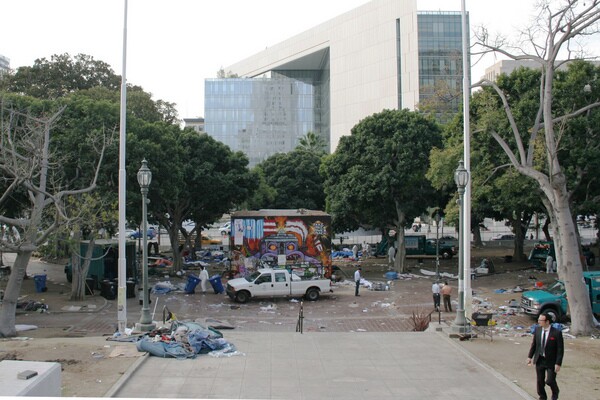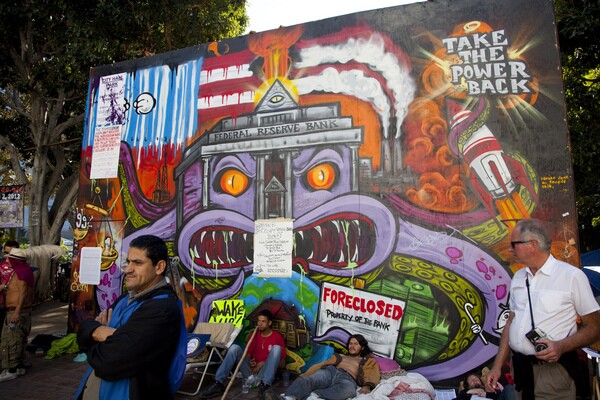Street Art Mural was the Last Protester Standing at Occupy L.A. Encampment

A pile of trash surrounds a mural protesting a pile of cash.
292 people were arrested early Wednesday morning when the LAPD shut down the 8-week-old Occupy L.A. encampment, extracting protesters from City Hall Park, including stragglers occupying trees.
The cleanup begins, and concrete barricades with a chain link fence now encircle the park closed for repair and restoration.
The tagline, "the world is watching," first used by Occupy Wall Street, was recanted by both protesters and LAPD's Chief Charlie Beck. In other cities, the movement depended on social media and visual reference to send out a statement against economic inequality and so-called excesses of the U.S. financial system.
Now biohazard crews sift through what was left behind, including a street mural that has been in the background of numerous photos coming out of the compound. It has become visual marker of its own. Occupiers have been seen with it during different moods: organizing, fatigued, sleeping, chanting, cheering, holding general assembly, linking arms, and then handcuffed.
There is no telling what will happen to the piece painted on a 20-foot plywood barricade installed by the city's Department of General Services to protect the 1933 Frank Putnam Flint Fountain. In the photo by the offices of Councilmember Paul Krekorian, preparing for a motion to study how a rebuilt park can have sustainable drought tolerate landscaping, the politicalized street art style stood with defiance the morning after.
A bank with angry eyes extends its tentacles through symbols of foreclosure, protecting the financial district--seen as a skyline of Los Angeles. Rich "Uncle" Pennybags, aka Mr. Monoply, appears in the bottom right corner with a declaration, "You're Bankrupt!" Industrial smoke from two stacks float over the background, becoming the stripes of the American flag, running into a field of blue and white stripes imprisoning two cartoon hands.
It added a distinct Los Angeles visual identity to the municipal location, and the piece taps into the art manifesto that a true mural is thick with political symbolism. This mural does that--not just by content, but location.
"All of the community murals, like any other public art, whether abstract or figurative, assert moral claims to public space, claims concerning the history, identity, and possible future of the surrounding area," said John Pitman Weber at a 2003 Getty symposium on the practice of 20th-century mural painting in the Americas. "Thus, art may become an important symbolic element in struggles over public space, a point of contention and a rallying point."
The Los Angeles mural has has an added kinship with another protest. Scott Olsen is the name signed to the mural sitting in City Hall Park, which is by chance the same name of 24-year-old Iraq war veteran injured at Occupy Oakland.
It could be saved as an artifact that marks the intent of a movement that first had support from City Hall, or be a reminder of how there was a line of communication between the city and the movement where both sides "had respect for each other," as the Mayor said during the day-after press conference.
But even if some call it a suppressed symbol of censorship if taken out, it can also just be saved as another chapter in the City Hall free speech lore.
However it plays out, the mural fulfills what Weber stated in 2003: Art marks public space as a point of contention.
Update: The Los Angeles Times is now reporting the city is looking atsaving the OccupyLA mural, still intact at the south lawn of City Hall. Carol Wells, the executive director for the Center for the Study of Political Graphics, told the Los Angeles Times the mural will be a "tangible reminder of this movement."
Debra J.T. Padilla, Executive Director of SPARC, said the Venice based non-profit was also asked to help save the mural from being trashed after being dismantled. "We are proposing to exhibit it on the front lawn of our center," said Padilla. "Let's hope we can make this happen. If nothing else, at least store it."


Photos: (Above) The mural on the trashed grounds of City Hall, with LAPD headquarters in the background I Photo by Jeremy Oberstein. (Below) Mural during OccupyLA, with permission from Sterling Davis. Mural after LAPD eviction, by Jeremy Oberstein


